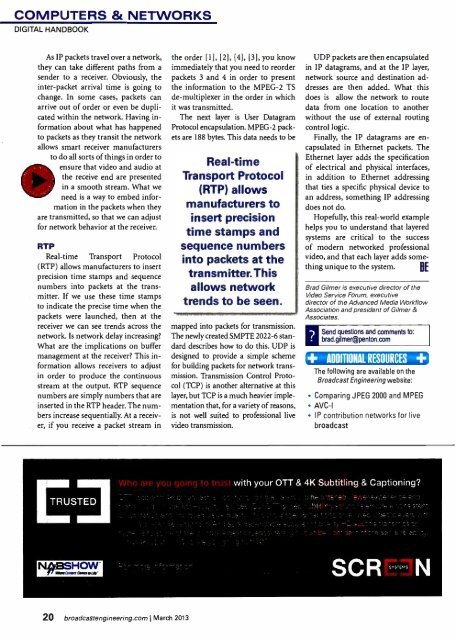ßroadcastEnsineerin - AmericanRadioHistory.Com
ßroadcastEnsineerin - AmericanRadioHistory.Com
ßroadcastEnsineerin - AmericanRadioHistory.Com
You also want an ePaper? Increase the reach of your titles
YUMPU automatically turns print PDFs into web optimized ePapers that Google loves.
COMPUTERS & NETWORKS<br />
DIGITAL HANDBOOK<br />
As IP packets travel over a network,<br />
they can take different paths from a<br />
sender to a receiver. Obviously, the<br />
inter -packet arrival time is going to<br />
change. In some cases, packets can<br />
arrive out of order or even be duplicated<br />
within the network. Having information<br />
about what has happened<br />
to packets as they transit the network<br />
allows smart receiver manufacturers<br />
to do all sorts of things in order to<br />
ensure that video and audio at<br />
the receive end are presented<br />
in a smooth stream. What we<br />
need is a way to embed information<br />
in the packets when they<br />
are transmitted, so that we can adjust<br />
for network behavior at the receiver.<br />
RTP<br />
Real -time Transport Protocol<br />
(RTP) allows manufacturers to insert<br />
precision time stamps and sequence<br />
numbers into packets at the transmitter.<br />
If we use these time stamps<br />
to indicate the precise time when the<br />
packets were launched, then at the<br />
receiver we can see trends across the<br />
network. Is network delay increasing?<br />
What are the implications on buffer<br />
management at the receiver? This information<br />
allows receivers to adjust<br />
in order to produce the continuous<br />
stream at the output. RTP sequence<br />
numbers are simply numbers that are<br />
inserted in the RTP header. The numbers<br />
increase sequentially. At a receiver,<br />
if you receive a packet stream in<br />
the order [1], [2], [4], [3], you know<br />
immediately that you need to reorder<br />
packets 3 and 4 in order to present<br />
the information to the MPEG -2 TS<br />
de- multiplexer in the order in which<br />
it was transmitted.<br />
The next layer is User Datagram<br />
Protocol encapsulation. MPEG -2 packets<br />
are 188 bytes. This data needs to be<br />
Real -time<br />
Transport Protocol<br />
(RTP) allows<br />
manufacturers to<br />
insert precision<br />
time stamps and<br />
sequence numbers<br />
into packets at the<br />
transmitter. This<br />
allows network<br />
trends to be seen.<br />
mapped into packets for transmission.<br />
The newly created SMPTE 2022 -6 standard<br />
describes how to do this. UDP is<br />
designed to provide a simple scheme<br />
for building packets for network transmission.<br />
Transmission Control Protocol<br />
(TCP) is another alternative at this<br />
layer, but TCP is a much heavier implementation<br />
that, for a variety of reasons,<br />
is not well suited to professional live<br />
video transmission.<br />
UDP packets are then encapsulated<br />
in IP datagrams, and at the IP layer,<br />
network source and destination addresses<br />
are then added. What this<br />
does is allow the network to route<br />
data from one location to another<br />
without the use of external routing<br />
control logic.<br />
Finally, the IP datagrams are encapsulated<br />
in Ethernet packets. The<br />
Ethernet layer adds the specification<br />
of electrical and physical interfaces,<br />
in addition to Ethernet addressing<br />
that ties a specific physical device to<br />
an address, something IP addressing<br />
does not do.<br />
Hopefully, this real -world example<br />
helps you to understand that layered<br />
systems are critical to the success<br />
of modern networked professional<br />
video, and that each layer adds something<br />
unique to the system.<br />
BE<br />
Brad Gilmer is executive director of the<br />
Video Service Forum, executive<br />
director of the Advanced Media Workflow<br />
Association and president of Gilmer &<br />
Associates.<br />
®Send questions and comments to:<br />
brad.gilmer @penton.com<br />
+ ADDITIONAL RESOURCES +<br />
The following are available on the<br />
Broadcast Engineering website:<br />
<strong>Com</strong>paring JPEG 2000 and MPEG<br />
AVC -I<br />
IP contribution networks for live<br />
broadcast<br />
TRUSTED<br />
with your OTT & 4K Subtitling & Captioning?<br />
h,:: =_-_ r:E"':' :- : .<br />
-.o<br />
NSHOW-<br />
...ati.a....-<br />
SCR<br />
5<br />
N<br />
20 broadcastengineering.com March 2013
















